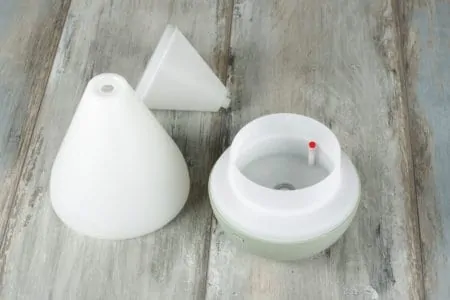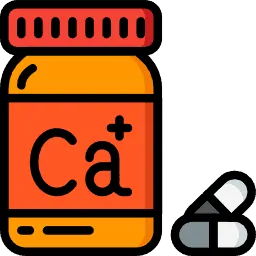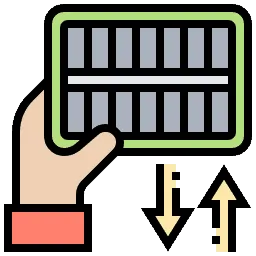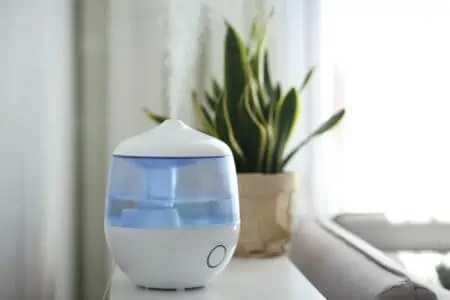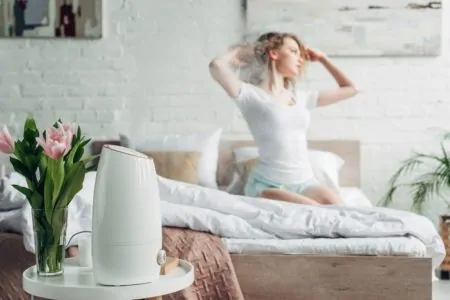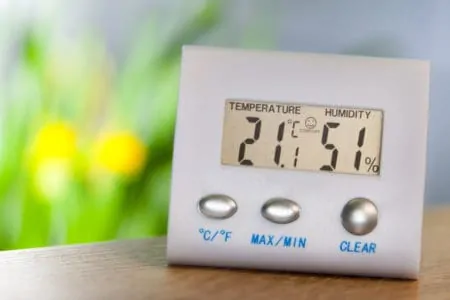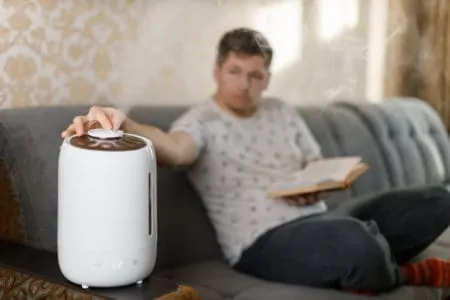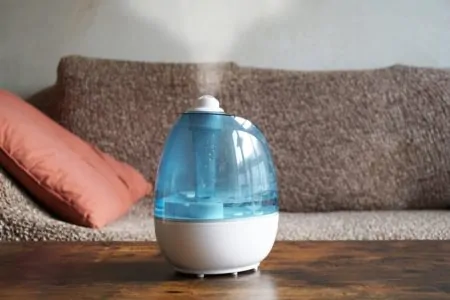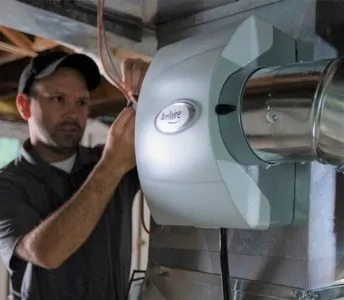Mold, limescale, and other contaminants quickly build up inside a humidifier’s tank and mist outlet. If this occurs, contaminants will spread through the air that you inhale. As a result, your humidifier could be causing more harm than good.
It’s vital that you know how to clean a humidifier. We’ll walk you through the five-step method you should carry out weekly. Plus, we’ll share tips for disinfecting a humidifier.
Key Takeaways
- Clean your humidifier weekly to prevent mold, bacteria, and contaminants from spreading in the air.
- Use distilled white vinegar to clean the tank and frame, as it’s a natural and effective cleanser.
- Disinfect your humidifier occasionally using bleach, vinegar, or hydrogen peroxide, but never mix these chemicals.
- Regular maintenance, like changing the water and checking for dampness, helps keep the humidifier clean and efficient.
How to Clean a Humidifier
There are several ways to get the task done, depending on how dirty it is. We’ll show you the most common ways to clean your humidifier, starting with a basic clean you can do regularly.
Cut Power First
Basic Humidifier Cleaning
Basic cleaning should be done regularly, around once a week.
- Time: 1.5 hours.
- Difficulty: Easy.
What You’ll Need
- Towel.
- Clean water.
- Distilled white vinegar.
- Sponge.
- Cotton swabs.
- Rice (optional).
- Cloth.
1. Rinse the Filter
After unplugging the humidifier, remove the filter and rinse it underneath the running faucet using cold water. Turn it every so often to ensure you clean all sides thoroughly. Then, place the filter on a clean towel and allow it to dry.
If your filter is starting to look worn, consider replacing it with a new filter. You can check the manual to see instructions on how to replace it and how often it should be done.
Keep In Mind
2. Clean the Tank
Remove the tank from the humidifier and empty the contents into the sink or drain. Next, fill it halfway with distilled white vinegar and swish it around to cover the bottom and sides. Allow the vinegar to sit in the tank for at least one hour.
Vinegar is a highly effective natural cleanser. Because it’s high in acid, it effectively dissolves mineral build-up and limescale. It can even remove mold.
If your tank is rather filthy, use a sponge to gently scrub the bottom and sides. You can also use a cotton swab to get into the tight corners.
Additionally, if your tank is small, add a small handful of rice with the vinegar and shake the tank. The rice will create a slurry and help dislodge gunk.
Warning
3. Rinse
After pouring out the vinegar, rinse the tank thoroughly with cold, clean water. You might need to rinse it several times to eliminate the vinegary scent.
4. Clean the Frame
Now that the tank is sparkling clean, it’s time to finish off with the frame. Dampen a sponge with vinegar and water and wipe the entire frame. Pay close attention to any small creases or crevices around the panel or dial.
5. Reassemble
Take a clean cloth and wipe the frame and tank to remove excess water. Place the dry filter back into the humidifier, fill it with water and enjoy a clean mist.
Disinfecting a Humidifier
Once in a while, it’s important to disinfect the humidifier. As we mentioned earlier, mold, bacteria, and contaminants are prone to residing within the tank and outlet. Here are a few ways to disinfect your humidifier.
Chemical Caution
Method 1: Bleach
Bleach is a harsh chemical, but it’s sometimes necessary to properly disinfect the tank. Fill the tank with clean water and add two teaspoons of bleach.
Allow the solution to sit for up to one hour maximum to sanitize the tank.
Pour the solution into a sink or drain and rinse the tank thoroughly with cold water. Rinse it well before placing it back onto the frame.
Method 2: Vinegar
Remove the filter. We don’t want it in the unit during this method, as the vinegar will damage it.
Pour one cup of vinegar into the tank and fill the rest of it with clean water. Place the tank on the frame and allow the humidifier to run for one hour — the vinegar will clean the mist outlet as it runs. You might want to do this outside or near an open window to avoid your house stinking of vinegar.
Never do this with chemical cleaners or bleach, as it will damage the internal parts of the humidifier. Additionally, it will spread the chemicals in the air.
Once the hour is up, empty the tank’s contents and rinse with clean water. Fill it once more with clean water and allow the humidifier to run for an hour to remove any vinegar that might be clinging to the outlet. Rinse the tank one last time once the hour is up.
No Essential Oils
Method 3: Hydrogen Peroxide
Peroxide is a milder form of bleach but just as effective. All you have to do is fill the tank halfway with peroxide and swish it around to cover the bottom and sides.
Leave the peroxide to sit in the tank for up to an hour before pouring it out. Then, rinse thoroughly with cold water.
Regular Maintenance
Cleaning your humidifier isn’t an everyday task. However, there are a few things you should do regularly to keep bacteria at bay.
1. Change the Water
Your humidifier might be able to hold over a gallon of water, but unless you run it continuously, it needs to be emptied.
When you leave the water to sit in the tank for an extended period, mold and bacteria are likely to grow. We recommend you empty your humidifier daily or every other day to avoid bacterial growth or mold.
2. Clean Regularly
Depending on how often you use your humidifier, we suggest you do a basic clean every week. You can either do a basic clean or disinfect the tank using one of the above methods. Deep clean the humidifier every two weeks, depending on usage.
3. Avoid Dampness
Humidifiers are effective, sometimes too effective. It’s essential to check the surrounding area for signs of dampness or excessive moisture. If the humidifier is set on a high setting, it could cause mold and bacterial growth in and around the tank.
To avoid this potential issue, turn the device down or off as soon as you feel like the air is at a comfortable humidity level.
4. Store Properly
If you only use your humidifier during dry seasons, such as winter, it’s essential to store it properly. Before packing it away, make sure you empty the tank entirely and do a deep clean. Wipe the tank and frame with a clean towel to remove any excess moisture.
In addition, when you take it out of storage, give it a quick clean to ensure there are no impurities.
5. Replace When Needed
It might be hard to say goodbye to a trusted appliance, but it’s necessary. An old humidifier might begin to break down if used a lot over the years. In addition, worn-out parts are more likely to have a significant amount of bacterial growth.
FAQs
Keeping It Clean
Keeping your humidifier clean is crucial to avoid mold, bacteria, and other contaminants. In addition, proper maintenance will help to keep your humidifier running for longer.
Cleaning the humidifier is easy and doesn’t require any expensive products. Depending on how filthy your humidifier is, you can do a basic clean or disinfect.
Vinegar is one of the best things to use when cleaning your humidifier. Whether it requires a quick clean or a more thorough job, we recommend you use vinegar.
